The construction industry is one of the most important and dynamic industries around the world. It is the backbone of the economy and is responsible for the development of countless infrastructure projects. To keep up with the increasing demand of modern construction projects, the industry must continually innovate and improve its processes. One such area is crane technology, which has been seeing major advancements in recent years. These innovations are helping to boost the efficiency of construction projects and making them safer and more cost-effective.
Benefits of Advances in Crane Technology
Crane technology has been around for centuries, but recent advances have made them more efficient and reliable. Modern cranes offer a wide range of features and benefits, such as:
- Improved safety: Modern cranes come with a range of safety features that make them much safer to operate. This includes safety brakes, overload protection, and anti-collision systems. These features help to reduce the risk of accidents and help to keep workers safe.
- Increased speed: Advances in crane technology have allowed cranes to move faster and lift heavier loads than ever before. This helps to speed up construction projects and helps to reduce labor costs.
- Improved accuracy: Modern cranes are designed with precision in mind, allowing for more accurate and precise movements. This helps to reduce the amount of time spent on tasks and ensures that the job is done right the first time.
- Increased efficiency: Modern cranes are designed to be more efficient than ever before. They are capable of lifting heavier loads with less effort, reducing downtime and increasing productivity.
Innovations in Crane Technology
The construction industry has seen a number of innovations in crane technology in recent years. These include:
- Remote Control: Remote control technology has allowed cranes to be operated from a distance, making them much safer and more efficient. This technology has made it possible to operate cranes from a remote location, eliminating the need for a human operator.
- Automation: Automation technology has made it possible to automate many of the tasks that a crane operator would normally perform. This includes tasks such as loading, unloading, and positioning. Automation makes it possible to operate a crane with minimal human intervention, making it more efficient and cost-effective.
- GPS Technology: GPS technology has allowed cranes to be tracked and monitored in real-time. This helps to improve safety and accuracy, as well as reducing the risk of accidents.
- Sensors: Sensors have been added to cranes to help monitor the environment around them. This helps to reduce the risk of accidents and improve the efficiency of operations.
Adoption of New Technologies
Many construction companies are beginning to adopt the latest technologies in crane technology. This includes using automated cranes, remote control, GPS tracking, and sensors. These technologies can help to reduce downtime and increase productivity, as well as improving safety and accuracy.
These technologies are also being used to reduce the cost of construction projects. For example, automated cranes can be programmed to perform certain tasks, eliminating the need for a human operator. This can help to reduce labor costs and increase efficiency.
Conclusion
Advances in crane technology have made it possible for construction companies to increase efficiency and reduce costs. These technologies are becoming more commonplace and are becoming essential for modern construction projects. They help to improve safety, accuracy, and productivity, making construction projects more cost-effective and efficient. The adoption of these technologies is helping to boost the efficiency of construction projects and is helping to make them safer and more cost-effective.






